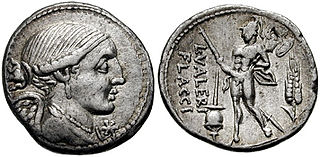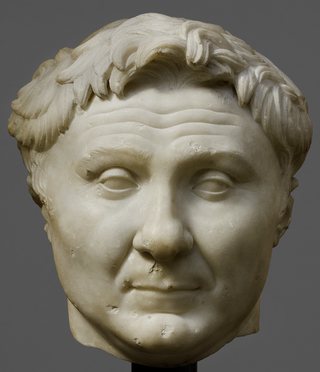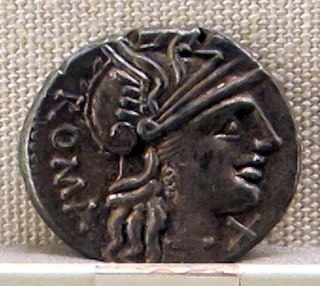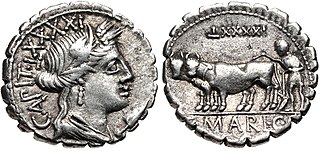Related Research Articles

The gens Valeria was a patrician family at ancient Rome, prominent from the very beginning of the Republic to the latest period of the Empire. Publius Valerius Poplicola was one of the consuls in 509 BC, the year that saw the overthrow of the Tarquins, and the members of his family were among the most celebrated statesmen and generals at the beginning of the Republic. Over the next ten centuries, few gentes produced as many distinguished men, and at every period the name of Valerius was constantly to be found in the lists of annual magistrates, and held in the highest honour. Several of the emperors claimed descent from the Valerii, whose name they bore as part of their official nomenclature.

The gens Pompeia was a plebeian family at ancient Rome, first appearing in history during the second century BC, and frequently occupying the highest offices of the Roman state from then until imperial times. The first of the Pompeii to obtain the consulship was Quintus Pompeius in 141 BC, but by far the most illustrious of the gens was Gnaeus Pompeius, surnamed Magnus, a distinguished general under the dictator Sulla, who became a member of the First Triumvirate, together with Caesar and Crassus. After the death of Crassus, the rivalry between Caesar and Pompeius led to the Civil War, one of the defining events of the final years of the Roman Republic.
The gens Papiria was a patrician family at ancient Rome. According to tradition, the Papirii had already achieved prominence in the time of the kings, and the first Rex Sacrorum and Pontifex Maximus of the Republic were members of this gens. Lucius Papirius Mugillanus was the first of the Papirii to obtain the consulship in 444 BC. The patrician members of the family regularly occupied the highest offices of the Roman state down to the time of the Punic Wars. Their most famous member was Lucius Papirius Cursor, five times consul between 326 and 313 BC, who earned three triumphs during the Samnite Wars. Most of the Papirii who held office under the later Republic belonged to various plebeian branches of the family. Although the most illustrious Papirii flourished in the time of the Republic, a number of the family continued to hold high office during the first two centuries of the Empire.

The gens Sempronia was one of the most ancient and noble houses of ancient Rome. Although the oldest branch of this gens was patrician, with Aulus Sempronius Atratinus obtaining the consulship in 497 BC, the thirteenth year of the Republic, but from the time of the Samnite Wars onward, most if not all of the Sempronii appearing in history were plebeians. Although the Sempronii were illustrious under the Republic, few of them attained any importance or notice in imperial times.

The gens Minucia was an ancient Roman family, which flourished from the earliest days of the Republic until imperial times. The gens was apparently of patrician origin, but was better known by its plebeian branches. The first of the Minucii to hold the consulship was Marcus Minucius Augurinus, elected consul in 497 BC.
The gens Anicia was a plebeian family at ancient Rome, mentioned first towards the end of the fourth century BC. The first of the Anicii to achieve prominence under the Republic was Lucius Anicius Gallus, who conducted the war against the Illyrians during the Third Macedonian War, in 168 BC.
The gens Caesonia was a plebeian family of ancient Rome. They first appear in history during the late Republic, remaining on the periphery of the Roman aristocracy until the time of Nero. Roman empress Milonia Caesonia, the last wife of the emperor Caligula was presumably descended from the Caesonii, as she bore their nomen. Another family of Caesonii attained the consulship several times beginning in the late second century; it is not clear how or whether they were related to the earlier Caesonii.

The gens Maria was a plebeian family of Rome. Its most celebrated member was Gaius Marius, one of the greatest generals of antiquity, and seven times consul.

The gens Pomponia was a plebeian family at ancient Rome. Its members appear throughout the history of the Roman Republic, and into imperial times. The first of the gens to achieve prominence was Marcus Pomponius, tribune of the plebs in 449 BC; the first who obtained the consulship was Manius Pomponius Matho in 233 BC.
The gens Cluvia was a plebeian family at ancient Rome, known from the later Republic, and early imperial times. The first member of the gens to achieve prominence was Gaius Cluvius Saxula, praetor in 175 and 173 BC.
Marcus Acilius Glabrio was a Roman senator who was appointed consul suffectus in 33 BC.

The gens Sosia, occasionally written Sossia, was a plebeian family at ancient Rome. Members of this gens occur in history from the end of the Republic down to the third century AD. The first of the Sosii to attain the consulship was Gaius Sosius in 32 BC, and the family would continue holding various positions in the Roman state until the third century.
The gens Mummia was a plebeian family at Rome. Members of this gens are first mentioned after the Second Punic War, and within a generation, Lucius Mummius Achaicus became the first of the family to obtain the consulship. Although they were never numerous, Mummii continued to fill the highest offices of the state through the third century AD.

The gens Stertinia was a plebeian family of ancient Rome. It first rose to prominence at the time of the Second Punic War, and although none of its members attained the consulship in the time of the Republic, a number of Stertinii were so honoured in the course of the first two centuries of the Empire.
The gens Oppia was an ancient Roman family, known from the first century of the Republic down to imperial times. The gens may originally have been patrician, as they supplied priestesses to the College of Vestals at a very early date, but all of the Oppii known to history were plebeians. None of them obtained the consulship until imperial times.
The gens Peducaea, occasionally written Paeducaea or Peducea, was a plebeian family at ancient Rome. Members of this gens occur in history from the end of the second century BC, and from then to the time of Antoninus Pius, they steadily increased in prominence. The first of the Peducaii to obtain the consulship was Titus Peducaeus in 35 BC.
The gens Rubria was a plebeian family at ancient Rome. Members of this gens are first mentioned in the time of the Gracchi, but they did not rise to prominence until imperial times. The first of the Rubrii to obtain the consulship was Rubrius Gallus, some time before AD 68.
The gens Rupilia, occasionally written Rupillia, was a minor plebeian family at ancient Rome. Members of this gens are first mentioned in the latter part of the Republic, and Publius Rupilius obtained the consulship in 132 BC. Few others achieved any prominence, but the name occurs once or twice in the consular fasti under the Empire. The name is frequently confounded with the similar Rutilius.
The gens Seia was a minor plebeian family of equestrian rank at ancient Rome. Members of this gens are first mentioned in the time of Cicero, and a few of them held various magistracies under the late Republic and into imperial times.
The gens Silia was a plebeian family at ancient Rome. Members of this gens are mentioned as early as the fifth century BC, but first to hold the consulship was Publius Silius Nerva, in the time of Augustus. The Silii remained prominent until the time of the Severan dynasty, in the early third century.
References
Citations
- 1 2 Dictionary of Greek and Roman Biography and Mythology, vol. I, p. 13 ("Acilia Gens").
- ↑ Millar, p. 341, note 1.
- ↑ Dictionary of Greek and Roman Biography and Mythology, vol. II, p. 270 ("Glabrio").
- 1 2 Chase, p. 110.
- ↑ Dondin-Payre, Les Acilii Glabriones, p. 34.
- ↑ Dictionary of Greek and Roman Biography and Mythology, vol. I, p. 455 ("Balbus").
- ↑ Dictionary of Greek and Roman Biography and Mythology, vol. I, p. 434 ("Aviola").
- ↑ New College Latin & English Dictionary, s. v. avia.
- 1 2 Broughton, vol. I, p. 352.
- ↑ Livy, xxx. 40, xxxi. 50, xxxiii. 24–26, 36, xxxv. 10, 24, xxxvi. 1, 2, 14, 28, 35, xxxvii. 6, 57.
- ↑ Appian, Syriaca, 17–21
- ↑ Polybius, xx. 9, 10, xxi. 1, 2.
- ↑ Plutarch, "The Life of Cato the Elder", 12, 13, 14.
- ↑ Florus, ii. 8. § 10.
- ↑ Aurelius Victor, De Viris Illustribus, 47, 54.
- ↑ Frontinus, Strategemata, ii. 4. § 4.
- ↑ Eutropius, iii. 4.
- ↑ Broughton, vol. I, pp. 320, 335, 352.
- ↑ Livy, xl. 34.
- ↑ Valerius Maximus, ii. 5. § 1.
- ↑ Obsequens, 76.
- ↑ Fasti Capitolini.
- ↑ Broughton, vol. I, pp. 386, 437, 449.
- ↑ Cicero, In Verrem, Act. Pr. 17, ii. 1, 9.
- ↑ Pseudo-Asconius, In Ciceronis in Verrem, Act. I, p. 149, Act. II, p. 165 (ed. Orelli).
- ↑ Broughton, vol. I, p. 517.
- ↑ Cicero, In Verrem, i. 2, 17, 18, Brutus, 68, Pro Lege Manilia, 2. § 5; 9, Epistulae ad Atticum, xii. 21, Philippicae, ii. 5.
- ↑ Pseudo-Asconius, In Ciceronis in Verrem, Act. II, v. 29, 63.
- ↑ Plutarch, "The Life of Sulla", 33, "The Life of Pompeius", 9, 30.
- ↑ Sallust, Historiae, v. p. 243 (ed. Gerlach).
- ↑ Cassius Dio, xxxv. 14, 17.
- ↑ Appian, Bella Mithridatica, 90.
- ↑ Broughton, vol. II, pp. 142, 143, 154.
- ↑ Broughton, vol. II, p. 414.
- 1 2 PIR, vol. I, p. 5.
- ↑ CIL VI, 31543 = ILS 5893.
- 1 2 3 4 5 PIR, vol. I, p. 8.
- ↑ Salomies, Adoptive and Polyonymous Nomenclature.
- ↑ Juvenal, Satirae, iv. 94–96.
- ↑ Suetonius, "The Life of Domitian", 10.
- ↑ Cassius Dio, lxvii. 12, 14.
- ↑ Juvenal, iv. 94.
- 1 2 3 PIR, vol. I, p. 7.
- ↑ Herodian, ii. 3. 4.
- 1 2 3 4 5 6 PIR, vol. I, p. 6.
- 1 2 3 4 5 6 7 8 PIR, vol. I, p. 9.
- ↑ Eck, "Zu lateinischen Inschriften aus Caesarea".
- ↑ Sivan, "A Late Gallic Branch of the Acilii Glabriones".
- ↑ CIL VI, 37118
- ↑ Jones, Martindale & Morris 1971, vol. 1, pp. 253, 396.
- ↑ CIL VI, 1678
- ↑ Jones, Martindale & Morris 1971, vol. 1, pp. 838–839.
- ↑ CIL VI, 32200
- 1 2 3 Cameron, "Anician Myths", p. 150.
- ↑ CIL VI, 526
- ↑ CIL XII, 133
- ↑ Cicero, De Senectute, 5, Epistulae ad Atticum, xii. 5.
- ↑ Pliny the Elder, vii. 36.
- ↑ Broughton, vol. I, p. 456.
- ↑ Obsequens, 97.
- ↑ Pliny the Elder, ii. 29, 56. s. 57.
- ↑ Broughton, vol. I, pp. 533, 534 (note 1).
- ↑ Tacitus, Annales, iii. 41.
- ↑ Gallivan, "Who Was Acilius?"
- ↑ Pliny, vii. 52. s. 53.
- ↑ Valerius Maximus, i. 8. § 12.
- ↑ PIR, vol. I, pp. 5, 6.
- ↑ Tacitus, Annales, xii. 64.
- ↑ Suetonius, "The Life of Claudius", 45.
- ↑ CIL VI, 41102.
- ↑ Gallivan, Paul (1978). "Who Was Acilius?". Historia: Zeitschrift für Alte Geschichte. 27 (4): 621–625. ISSN 0018-2311. JSTOR 4435641.
- ↑ Livy, xxxii. 29, xxv. 39, xxxv. 14.
- ↑ Gellius, vii. 14.
- ↑ Plutarch, "The Life of Cato the Elder", 22, "The Life of Romulus", 21.
- ↑ Macrobius, i. 5.
- ↑ Dionysius, iii. 77.
- ↑ Cicero, De Officiis, iii. 32.
- ↑ Broughton, vol. I, pp.
- ↑ Caesar, De Bello Civili, iii. 15, 16, 39.
- ↑ Cicero, Epistulae ad Familiares, vii. 30, 31, xiii. 30–39.
- ↑ RE, vol. I (1), cols. 252–253 ("Acilius 15", Elimar Klebs).
- ↑ Broughton, vol. II, pp. 280, 285 (note 8), 296, 308, 326; vol. III, p. 1.
- ↑ Seneca the Younger, Epistulae, cxxii. 10, 12, 13.
- ↑ Pliny the Elder, xiv. 48.
- 1 2 Dictionary of Greek and Roman Biography and Mythology, vol. II, pp. 1010, 1011 ("M. Annaeus Mela").
- ↑ Pliny the Younger, Epistulae, i. 14, 6.
- ↑ RE, vol. I (1), col. 259 ("Acilius 52", Paul von Rohden).
- ↑ Eck, "Jahres- und Provinzialfasten der senatorischen Statthalter von 69/70 bis 138/139".
- ↑ Aelius Spartianus, "The Life of Hadrian", 1, 3, 5, 9, 15.
- ↑ PIR, vol. I, pp. 6, 7.
- ↑ Jones, Martindale & Morris 1971, vol. 1, p. 834.
Bibliography
- Polybius, Historiae (The Histories).
- Marcus Tullius Cicero, Brutus , Cato Maior de Senectute , De Officiis , Epistulae ad Atticum , Epistulae ad Familiares , In Verrem , Philippicae , Pro Lege Manilia .
- Pseudo-Asconius, Commentarius in Oratorio Ciceronis in Verrem (Commentary on Cicero's In Verrem), ed. Orelli.
- Gaius Sallustius Crispus (Sallust), Historiae (The Histories).
- Gaius Julius Caesar, Commentarii de Bello Civili (Commentaries on the Civil War).
- Titus Livius (Livy), History of Rome .
- Dionysius of Halicarnassus, Romaike Archaiologia (Roman Antiquities).
- Valerius Maximus, Factorum ac Dictorum Memorabilium (Memorable Facts and Sayings).
- Lucius Annaeus Seneca (Seneca the Younger), Epistulae Morales ad Lucilium (Moral Letters to Lucilius).
- Gaius Plinius Secundus (Pliny the Elder), Naturalis Historia (Natural History).
- Gaius Plinius Caecilius Secundus (Pliny the Younger), Epistulae (Letters).
- Sextus Julius Frontinus, Strategemata (Stratagems).
- Decimus Junius Juvenalis, Satirae (Satires).
- Publius Cornelius Tacitus, Annales .
- Plutarchus, Lives of the Noble Greeks and Romans .
- Gaius Suetonius Tranquillus, De Vita Caesarum (Lives of the Caesars, or The Twelve Caesars).
- Lucius Annaeus Florus, Epitome de T. Livio Bellorum Omnium Annorum DCC (Epitome of Livy: All the Wars of Seven Hundred Years).
- Appianus Alexandrinus (Appian), Bella Mithridatica (The Mithridatic Wars), Syriaca (The Syrian Wars).
- Aulus Gellius, Noctes Atticae (Attic Nights).
- Herodianus, History of the Empire from the Death of Marcus.
- Lucius Cassius Dio Cocceianus (Cassius Dio), Roman History.
- Aelius Lampridius, Aelius Spartianus, Flavius Vopiscus, Julius Capitolinus, Trebellius Pollio, and Vulcatius Gallicanus, Historia Augusta (Augustan History).
- Julius Obsequens, Liber de Prodigiis (The Book of Prodigies).
- Eutropius, Breviarium Historiae Romanae (Abridgement of the History of Rome).
- Sextus Aurelius Victor, De Viris Illustribus (On Famous Men).
- Macrobius Ambrosius Theodosius, Saturnalia.
- Dictionary of Greek and Roman Biography and Mythology , William Smith, ed., Little, Brown and Company, Boston (1849).
- Theodor Mommsen et alii, Corpus Inscriptionum Latinarum (The Body of Latin Inscriptions, abbreviated CIL), Berlin-Brandenburgische Akademie der Wissenschaften (1853–present).
- Chase, George Davis (1897), "The Origin of Roman Praenomina", Harvard Studies in Classical Philology, vol. 8, Cambridge: Harvard University Press, pp. 103–184, doi:10.2307/310491, JSTOR 310491 .
- Paul von Rohden, Elimar Klebs, & Hermann Dessau, Prosopographia Imperii Romani (The Prosopography of the Roman Empire, abbreviated PIR), Berlin (1898).
- Hermann Dessau, Inscriptiones Latinae Selectae (Select Latin Inscriptions, abbreviated ILS), Berlin (1892–1916).
- August Pauly, Georg Wissowa, et alii, Realencyclopädie der Classischen Altertumswissenschaft , J. B. Metzler, Stuttgart (1894–1980).
- T. Robert S. Broughton, The Magistrates of the Roman Republic, American Philological Association (1952).
- Fergus Millar, The Emperor in the Roman World, Cornell University Press, Ithaca, New York (1977).
- Paul Gallivan, "Who Was Acilius?", in Historia: Zeitschrift für Alte Geschichte , vol. 27, p. 622 (1978).
- Werner Eck, "Jahres- und Provinzialfasten der senatorischen Statthalter von 69/70 bis 138/139", in Chiron, vol. 12, pp. 357–359 (1982), "Zu lateinischen Inschriften aus Caesarea in Iudaea/Syria Palaestina", in Zeitschrift für Papyrologie und Epigraphik , vol. 113, pp. 129–143 (1996).
- Hagith Sivan, "A Late Gallic Branch of the Acilii Glabriones? Notes on Ausonius' 'Professores' 24 (Peiper)", in Mnemosyne, Fourth Series, vol. 44, pp. 435–439 (1991).
- Olli Salomies, Adoptive and Polyonymous Nomenclature in the Roman Empire, Societas Scientiarum Fennica, Helsinki, vol. 97, pp. 149 ff (1992).
- Monique Dondin-Payre, Exercise du Pouvoir et Continuité Gentilice: les Acilii Glabriones, Rome: École Française de Rome (1993).
- John C. Traupman, The New College Latin & English Dictionary, Bantam Books, New York (1995).
- Alan Cameron, "Anician Myths", in Journal of Roman Studies , vol. 102 (2012).
- Jones, A. H. M.; Martindale, J. R.; Morris, J., eds. (1971). The Prosopography of the Later Roman Empire . Vol. 1. Cambrdridge University Press.